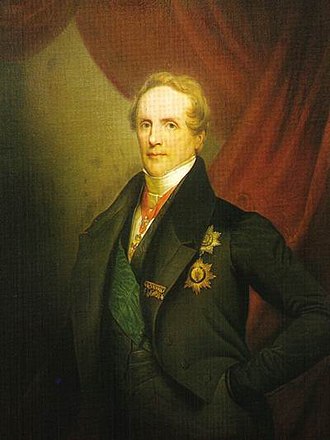by Scott Mehl © Unofficial Royalty 2017

Carola of Vasa, Queen of Saxony – source: Wikipedia
Queen Carola was the wife of King Albert of Saxony, and the last Queen of Saxony. She was born Princess Karolina Fredrika Franciska Stefania Amalia Cecilia of Vasa on August 5, 1833, at Schönbrunn Palace in Vienna. Austria. Her parents were Gustav, Prince of Vasa (formerly Crown Prince of Sweden) and Princess Luise Amelie of Baden, and she had one older sibling Prince Louis who was born and died in March 1832.
Despite her title, Carola was not actually a member of the Vasa dynasty. Her grandfather King Gustaf IV Adolf of Sweden had been forced to abdicate the throne in 1809 and was eventually replaced by his uncle King Karl XIII. Karl had no children and this led to the choosing of Jean Baptiste Bernadotte to succeed him, thus establishing the Bernadotte dynasty which remains on the Swedish throne today. The family was forced to leave Sweden. Carola’s father and his siblings settled in Austria, where he went on to serve in the Austrian forces. No longer permitted to be styled a Prince of Sweden, he took on the title Prince of Vasa, a nod to the dynasty that had previously ruled Sweden in the 16th and 17th centuries.
Carola was christened two days after her birth. Her godparents included Franz I, Emperor of Austria, Caroline Augusta of Bavaria, Empress of Austria, Stephanie de Beauharnais, Grand Duchess of Baden, and Cecilia of Sweden, Grand Duchess of Oldenburg. Her early years were spent primarily at Eichhorn Castle in what is now Brno, Czech Republic. After her parents divorced in 1844, Carola and her mother moved to the Morawetz Castle in Morawetz (link in Czech), also now in the Czech Republic. Given a strict education, Carola developed a love of drawing and painting and a deep compassion for those less fortunate. This strong desire to help others continued for her entire life.
Carola was known as one of the most beautiful European princesses and had numerous suitors. Plans for a marriage to the French Emperor Napoléon III were refused by her father, who was strongly opposed to the Napoleonic monarchy and concerned by the unstable political situation in France.

Crown Prince Albert of Saxony. source: Wikipedia
In November 1852, Carola and her mother received a visit from Crown Prince Albert of Saxony, the son of King Johann of Saxony and Amalie Auguste of Bavaria. Albert was on a quest to find a suitable bride, and having been turned down by several others, set his sights on Carola. They became engaged on December 5, 1852. The following month, Carola and her mother moved to Brno, where Albert visited often. In June 1853, she made her way to the Kingdom of Saxony, arriving in Dresden, Kingdom of Saxony, now in the German state of Saxony, accompanied by Albert, to a grand welcome from the people of Saxony. They married in the Dresden Cathedral on June 18, 1853. After two weeks of celebrations, they took up residence in the Taschenbergpalais in Dresden. Carola and Johann never had children. Between 1853 – 1860, Carola had ten miscarriages.

Crown Princess Carola, c1865. source: Wikipedia
As Crown Princess, Carola quickly became involved in charity work. She visited field hospitals in Vienna and founded the Albert Commission, which supported military care during the War of 1870-1871. She took over the patronage of several organizations that supported widows and orphans and provided food and medical care for wounded soldiers. She founded several hospitals and nursing schools. In recognition of her work, Carola was awarded several orders including the Saxon Order of Sidonia and the Prussian Order of Luise.
These activities increased further after her husband ascended the Saxony throne on October 29, 1873. In addition to supporting organizations that provided medical care, she was also instrumental in establishing several organizations to provide training for a growing workforce due to increased industrialization. Through her efforts, homes were built for families who needed housing, nurses received more proper training, and advances were made in the care and treatment of tuberculosis. Schools and nursing homes were established, along with several women’s organizations that provided vocational training. Queen Carola is often credited for greatly contributing to the increasing professional independence of women.

Queen Carola, c1902. source: Wikipedia
Carola was widowed in 1902 and retired to her country home in Strehlen, Kingdom of Saxony, now Strzelin, Poland, appearing in public only occasionally. She continued working with several of her patronages, but most were passed on to the new Queen. Living a relatively simple life in Strehlen, the Dowager Queen spent several years working on, and constantly revising, her will which would end up giving a large part of her estate to charity. Her health began to decline, as a result of diabetes, which she had suffered from for several years. She died on the morning of December 15, 1907, at her villa in Strehlen. After laying in state at her villa, her coffin was taken to the Dresden Cathedral in Dresden, Kingdom of Saxony, now in Saxony, Germany where she is buried beside her husband in the Wettin Crypt.
This article is the intellectual property of Unofficial Royalty and is NOT TO BE COPIED, EDITED, OR POSTED IN ANY FORM ON ANOTHER WEBSITE under any circumstances. It is permissible to use a link that directs to Unofficial Royalty.
Saxony Resources at Unofficial Royalty















